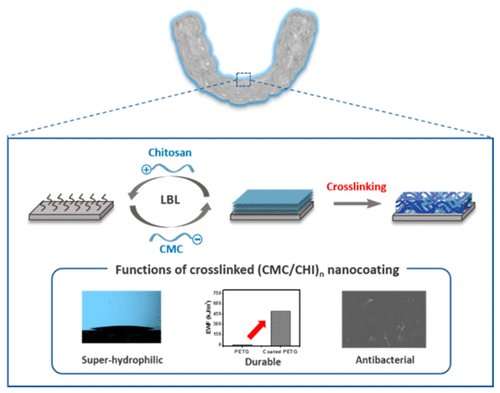Helping dental retainers and aligners fight off bacteria

Clear, plastic aligners have been growing in popularity as alternatives to bulky, metal braces. And once the teeth are straightened, patients graduate to plastic retainers to maintain the perfect smile. But these appliances can become contaminated, so one group is now reporting in ACS Applied Materials & Interfaces that they have developed a film to prevent bacteria from growing on them.
According to the American Association of Orthodontists, more than 5 million people seek orthodontic treatments each year. These procedures include braces and aligners, a set of plastic pieces that shift the teeth slightly over time, in an attempt to fix crowded jaws, over- and under-bites and improperly aligned teeth. Clear aligners or retainers, known collectively as clear overlay appliances (COAs) are made by taking a dental cast and using pressure or heat on a plastic sheet. But bacteria frequently build up on COAs as difficult-to-treat biofilms, and the plastics easily wear down. Scientists have turned to developing simple and affordable coatings to combat this. Drawing inspiration from super-hydrophilic antibacterial coatings on other medical devices, Hyo-Won Ahn, Jinkee Hong and colleagues wanted to see if they could make something similar for COAs in the unique oral environment.
The researchers took a polymer sheet made of polyethylene terephthalate that was modified with glycol (PETG) and layered films of carboxymethylcellulose and chitosan on it. This layered film created a super-hydrophilic surface, or a surface that loves water, that prevented bacteria from adhering. When PETG with the film was compared to the bare material, bacterial growth was reduced by 75 percent. The coated plastic also was stronger and more durable, even when tested with artificial saliva and various acidic solutions.
More information: Sohyeon Park et al. A Polysaccharide-Based Antibacterial Coating with Improved Durability for Clear Overlay Appliances, ACS Applied Materials & Interfaces (2018). DOI: 10.1021/acsami.8b04433
Abstract
Clear overlay appliances (COAs) are widely used in orthodontic fields because they offer many advantages, such as cost-effectiveness, good formability, and good optical characteristics. However, it is necessary to frequently replace COAs because the thermoplastic polymers that are used to fabricate COAs have poor abrasion resistance and have a tendency to induce bacterial accumulation. Here, we have developed polysaccharide-based antibacterial multilayer films with enhanced durability, intended for COA applications. First, multilayer films composed of carboxymethylcellulose (CMC) and chitosan (CHI) were fabricated on polyethylene terephthalate glycol-modified (PETG), which was preferred material for COA fabrication, via a layer-by-layer (LbL) technique. Next, chemical cross-linking was introduced within the LbL-assembled multilayer films. The LbL-assembled CMC/CHI film, which was made porous and rough by the cross-linking, formed a superhydrophilic surface to prevent the adhesion of bacteria and exhibited a bacterial reduction ratio of ∼75%. Furthermore, the cross-linking of the multilayer film coated on the PETG also improved the chemical resistance and mechanical stability of the PETG under simulated intraoral conditions with artificial saliva, by increasing the bond strength between the polysaccharide chains. We attempted to accumulate datasets using our experimental design and to develop sophisticated methods to assess nanoscale changes through large-scale measurements.
Journal information: ACS Applied Materials and Interfaces
Provided by American Chemical Society

















